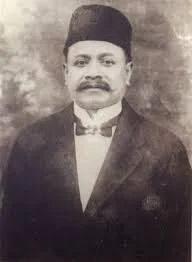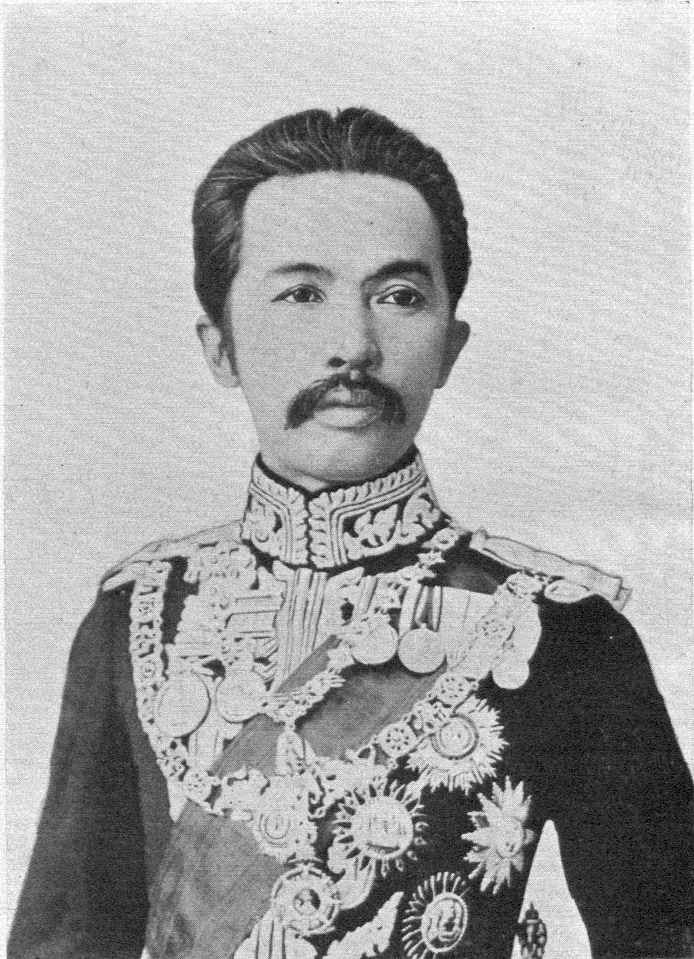Raja Abdul Karim Kamaruddin, the last Malay ruler of Pattani
A key event in our novel, Beads on a String, is the ouster of Raja Abdul Karim Kamaruddin as raja of Pattani. One of our main characters, Pakdee, plays an important role in a deception that leads to the raja’s arrest in 1902 and the defeat of Malay uprisings in 1910. Abdul Karim was in line to succeed his father when he died in 1899, but the Siamese government changed his status from ruler of a tributary state to a Siamese government official. King Chulalongkorn’s policy was to bring the previously semi-independent Malay sultanates into his newly centralized administration.
The king’s talented half-brother, Interior Minister Prince Damrong Rajanubhab, was in charge of the difficult process of reorganizing almost every aspect of the Siamese administration. A key step was redirecting tax revenues that previously went to the local ruler so that revenues flowed to Bangkok for later distribution to the provinces.
Another step was reform of the criminal justice system to provide government courts with trained judges throughout the country. This was particularly important in the Malay areas where sultan-appointed judges used an uncertain mixture of Malay traditions – adat – and sharia laws to render legal decisions. Abdul Karim sat at the top of this system, retaining the power to make or over-rule any legal judgment.
In our novel the king’s reform effort and the maneuvers to thwart Abdul Karim are crucial to Pakdee’s rise to a senior position in the administration of the south.
We have relied on the work of scholars such as Dr. Surin Pitsuwan, Tej Bunnag, Carool Kersten, Zulkiflee Masae, Ibrahim Syukri, Dr. Chaiwat Satha-Anand and others for the historical context for our story. But there is enough that is not documented about the arrest of Raja Abdul Karim to allow us to use our imaginations to make Pakdee a pivotal character.
Dr. Chaiwat’s account was particularly useful as he relates the controversy over the Malay language translation of a Thai language letter presented by a high Siamese official, Phraya Sri Sahathep, for signature by Abdul Karim. The raja refused to sign until he was given a Malay language translation. The Thai language version of the letter indicated approval of the appointment of a Siamese official to oversee and control the government of Pattani, but the Malay translation did not.
Dr. Chaiwat wrote, as translated by us:
“Phraya Sri Sahathep asked a staff member to translate that letter and read it to the raja of Pattani. After the reading (of the Malay) translation, Phraya Sri Sahathep reaffirmed that Pattani would not have any obligation (to submit to control by a government official).”
A key scene in our book depicts the meeting between Abdul Karim and Phraya Sri Sahathep, with Pakdee as the translator of the letter. This is what we wrote:
Standing to one side of the raja, Pakdee looked out over the assembled officials, the Malays with their turbans, the Thais in their white uniforms with colorful medals. All stood stiffly before the seated raja and vice minister. He held the Jawi and Thai letters in a velvet bag against his chest. He could feel the rapid beating of his heart. There was a mumble of conversation and then the raja’s secretary called in a loud voice: “Haji Wan Mohammed al Fatani.”
He had been waiting for this moment. He bowed to both dignitaries and then knelt to present the bag to the raja. Abdul Kadir pulled out the two documents inside and focused on the Jawi language letter. Then he looked up and held out the Jawi letter.
“Haji Wan, read your translation aloud so all can hear it,” he ordered.
His throat went dry and his tongue felt thick. He could see Phraya Sukhumnaiwinit nodding encouragement. The text looked blurred for a moment. Then it cleared and he began to read.
“Louder, so all can hear,” the raja said.
He cleared his throat and started again. It seemed to take forever to finish. Finally there was no more and he handed the paper back to the raja.
“This is a little blunt, not as elegant as I might write it, but, if that is the tone of the Thai letter, I like it. It is time to be clear about the problems that have been visited upon us by the actions of the commissioner. Is this a full and accurate translation?”
His heart raced, but he forced himself to reply. “Yes, Your Royal Highness. This is full and accurate.”
The raja smiled. “Then I will sign.”
Prince Damrong Rachanubhab, minister of the interior from 1894 to 1915.
It was only a few months later that Prince Damrong ordered the raja’s arrest for his refusal to accept supervision by a government official in contradiction to the signed letter to King Chulalongkorn. This was a turning point in the relations between the government in Bangkok and the majority Malay areas in the south. The arrest quashed Abdul Karim’s hopes of leading an armed uprising against the government, but it made many Malays feel like subjugated people. It also motivated Abdul Karim to stir up feelings against the Siamese government that led to armed uprisings in 1910, 1911 and 1922. Even today, the arrest of the Pattani raja is seen as a key event leading to the violence that continues to plague the far south.
In the novel, we made Pakdee the official who made the deceptive translation at the behest of his boss, Phraya Sukhumnaiwinit.
We could not find any other account that details the issue of the translation of the raja’s letter to the king, but Ibrahim Syukri, although differing in the details, writes of Siamese “trickery and deceit”:
“He (King Chulalongkorn) sent a minister as envoy to Patani in order to discuss this matter with the Malay rajas. In this meeting he requested the signatures of the Malay rajas as a token of permission and agreement with the wish of the king of Siam. At the same time he promised to give pensions to the rajas and their households until their deaths. However, the rights and revenues in the country of Patani all had to be surrendered to the king of Siam in Bangkok. By using all sorts of trickery and deceit many of the Malay rajas were deceived so that they were willing to give their signatures admitting agreement with the wishes of the king of Siam.”
In the novel we keep as close as possible to the historical record of Malay unrest, but again we place our fictional character, Pakdee, in a key role in the actual Malay uprising of 1910. We make Pakdee’s younger brother, Saifan, a devout Muslim who moved to Pattani after Pakdee’s arrest, part of the group that attacked a district office and police station. The attack is defeated due to information provided by one of Pakdee’s spies. Pakdee, however, is alarmed to learn that his brother was wounded in the fighting and gets one of his men to help him escape and get medical treatment.
We could not find many details of that 1910 violence, other than it was incited by To’ Tae, a Sufi cleric close to Abdul Karim and that it was quickly defeated with the deaths and arrests of most of the Malay fighters. So, if any of our readers can suggest additional sources for those events, we would greatly appreciate it. The novel is still in draft form so changes can easily be made.
Throughout the book we use the character of Saifan to explain the feelings and lives of the people of Pattani. Pakdee, in contrast, shows what it might have been like to adapt to the hierarchical values of the Thai ruling class at a time of wrenching change.
We hope that our fictionalized account will make learning about these critical events in Thailand’s history more accessible and interesting for today’s readers.

